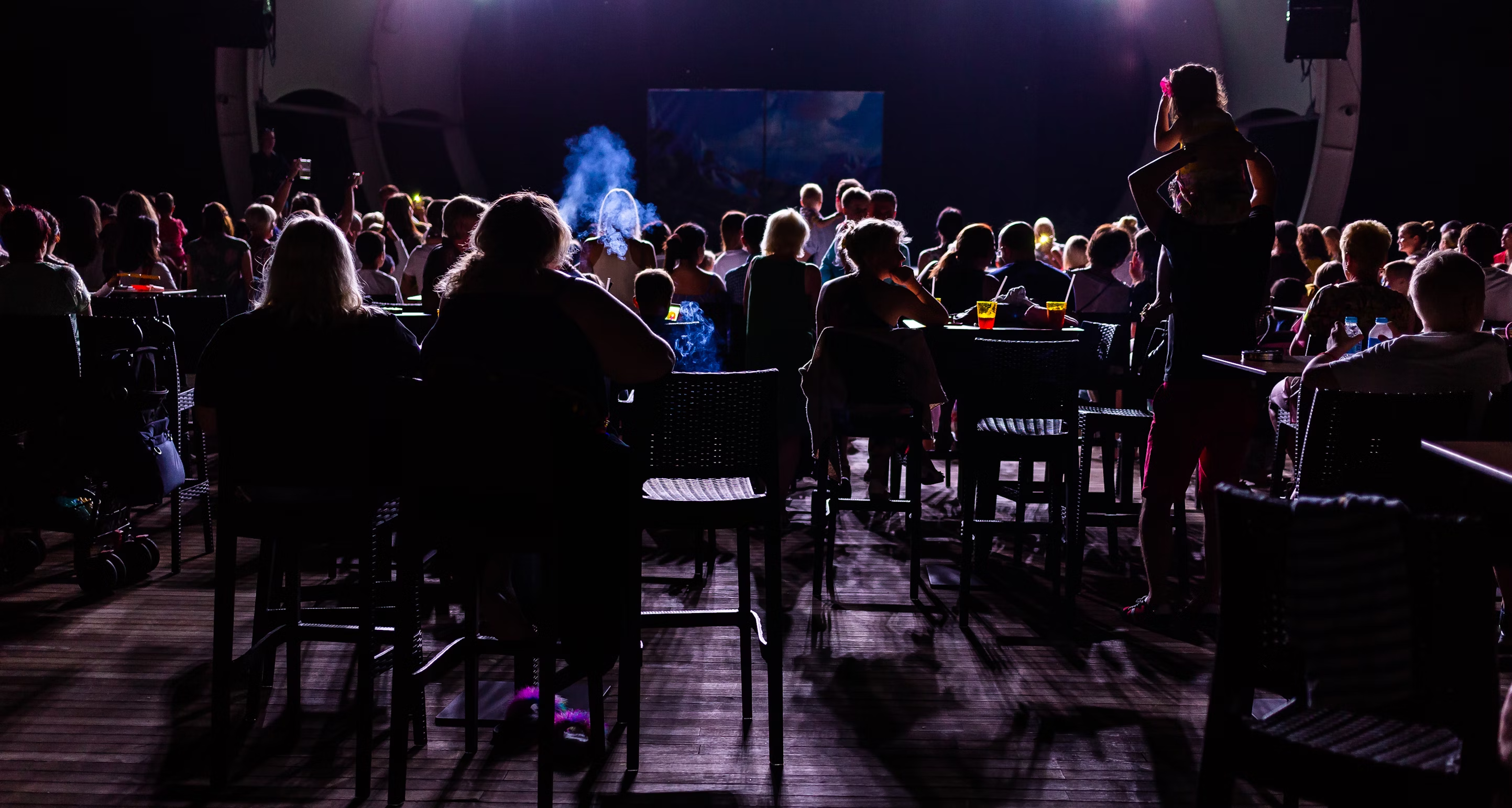The stage is set, but it's not what you'd typically imagine. Picture a theater without walls, a stage without curtains, an arena without a single set seat. This is the intriguing world of theater in non-traditional spaces. But what exactly does it mean?
1. Explore the concept of non-traditional theater spaces
The traditional theater has been the centerpiece of performing arts for centuries. Rows of velvet covered seats, a grand stage, ornate curtains, and the smell of roasting chestnuts in the lobby—sounds familiar, right? Now let's flip the script.
Non-traditional theater spaces are exactly what they sound like—spaces that break the mold of the traditional theater setting. These are performances that take place in the most unexpected locales: from abandoned warehouses to bustling city streets, from serene parks to the depths of the underground subways.
Think outdoor amphitheaters under starlit skies or an intimate performance in a cozy café — these are the stages of non-traditional theater.
While the concept of theater in non-traditional spaces might seem unconventional, it is not new. Street performances and traveling troupes have been a part of human culture for millennia. What is new, however, is the mainstream acceptance and recognition of these spaces as valid and valuable platforms for theatrical expression.
These non-conventional venues offer a breath of fresh air, transforming the way you perceive and experience theater. The beauty of non-traditional theater spaces is that they are not just about the where, but also about the how. They encourage artists to rethink the dynamics of their performance, to rewrite the rules, and to reimagine what theater can be.
So, are you ready to step out of the box and explore the uncharted territory of theater in non-traditional spaces?
2. Identify the Benefits of Performance Art in Unconventional Venues
The world of theater in non-traditional spaces opens up a plethora of possibilities not just for the performers, but also for the audience. So, why should you give this unconventional theater a whirl? Let's dive in.
Firstly, non-traditional spaces add a whole new dimension to the storytelling process. Imagine watching a play about a shipwreck...on a boat! The location itself becomes an active participant in the performance, setting the mood and creating immersive experiences that a standard theater setup might not offer.
Secondly, these performances often encourage increased audience interaction. In a warehouse or a park, the line between the stage and the audience blurs. You're not just a passive observer; you become a part of the performance.
Next, non-traditional theater spaces can be a catalyst for creativity. Constraints breed creativity, and working within the limitations of a non-conventional venue often leads to innovative staging, unique narratives, and fresh performance styles.
Finally, theater in unconventional venues is a great way to reach new audiences. Traditional theater can sometimes feel intimidating or inaccessible to some. Non-traditional venues, however, often feel more welcoming and can attract a diverse crowd, making theater a truly inclusive art form.
There you have it. Going non-traditional not only breaks the monotony but also offers a buffet of benefits that can breathe new life into your theater experience. So, why not take the plunge and dive into the world of theater in non-traditional spaces?
3. Discuss the Challenges and Solutions in Non-Traditional Theater
While the world of theater in non-traditional spaces can be an exciting playground, it does come with its own set of hurdles. However, every challenge is a stepping stone to creative solutions. Let's take a look at some of these obstacles, and how they can be overcome.
Challenge: Navigating Technical Limitations
Non-traditional spaces can present a host of technical difficulties, from lighting to acoustics. A park at dusk might have the perfect ambiance for your play, but how do you ensure your actors can be seen and heard?
Solution: Portable, battery-operated tech gear is your best bet here. Compact LED lights, wireless microphones, and portable stage sets can help you navigate the technical landscape.
Challenge: Weather-Related Issues
Outdoor venues are great, until it starts to rain. Weather unpredictability is a common challenge when it comes to theater in non-traditional spaces.
Solution: Always have a backup plan. Secure a nearby indoor location, or invest in weatherproof equipment. Also, consider the seasons and weather patterns when planning your performance dates.
Challenge: Legal Constraints
From city permits to noise restrictions, legal hurdles can pop up when you're planning a performance in a non-traditional space.
Solution: Do your homework. Research local laws and secure necessary permits well in advance. Develop good relationships with local authorities to ensure a smoother process.
Challenge: Audience Comfort
The novelty of a non-traditional theater can be thrilling, but it can also mean sacrificing some comforts associated with traditional venues, like comfortable seating.
Solution: Think creatively about comfort. Rent portable seating, provide cushions, or even encourage audiences to bring their own blankets or chairs.
Non-traditional theater is all about breaking the mold and reimagining what's possible. Yes, there will be challenges, but with a little bit of creativity and a lot of planning, you can turn these challenges into opportunities and create a truly memorable theater experience.
4. Showcase Successful Examples of Theater in Non-traditional Spaces
The concept of theater in non-traditional spaces is not new. In fact, many theatrical productions have successfully navigated this territory and emerged triumphant. Here are a few notable examples that have taken the road less traveled in the world of theater.
Punchdrunk's "Sleep No More"
This immersive production took Shakespeare's Macbeth to a whole new level. Instead of the confines of a traditional theater, Punchdrunk staged "Sleep No More" in a multi-story warehouse in New York. Audiences were free to roam the space, creating their own experience as they encountered different scenes and characters.
Shunt's "Money"
London-based collective, Shunt, turned a disused railway tunnel into a space for their interactive performance, "Money". The audience was encouraged to participate and engage with the story, which unfolded around them in the atmospheric underground location.
Third Rail Projects' "Then She Fell"
A former hospital in Brooklyn served as the venue for Third Rail Projects' "Then She Fell". Inspired by Lewis Carroll's Alice in Wonderland, the show took audiences on a journey through various rooms, each with its own unique performance.
The Globe Theatre's "Shakespeare on the Beach"
The Globe Theatre brought Shakespeare to the great outdoors with their "Shakespeare on the Beach" series. Actors performed beloved plays against the backdrop of the setting sun, with the audience seated on beach chairs and blankets.
These productions have not only proven that theater in non-traditional spaces is feasible, but they've shown that it can be immensely successful. They embraced the challenges, turned them into opportunities, and created unforgettable experiences for their audiences. This just goes to show that the only limit to what theater can be, is the sky.
5. Guidelines for Creating Your Own Performance in a Non-Traditional Space
If you're ready to break free from the stage and create your own theater in non-traditional spaces, that's fantastic! We're here to guide you through the process. Let's get started.
Understand Your Space
Before you jump headfirst into your project, really get to know your chosen space. Spend time there. Understand its atmosphere, its acoustics, and its unique features. Can you use that old tree in your park venue as a prop? Would the echo in that alleyway add a spooky effect to your ghost story? The space is as much a part of your performance as your actors are, so use it to its full advantage.
Create an Immersive Experience
Remember, the beauty of non-traditional theater is the chance to immerse your audience in the story. Don't just let them watch; encourage them to participate. This could be as simple as moving around the space or as complex as interacting with the actors. Make your audience feel like they're a part of the narrative.
Prioritize Safety
While experimenting with non-traditional spaces can be exciting, safety should always be your first priority. Make sure the area is safe for both your actors and your audience. Clear any potential hazards, have a first-aid kit on hand, and always have a contingency plan.
Adapt Your Story to the Space
Let your chosen space inspire your story. If you're performing in a historic house, maybe consider a period piece. If you're in a bustling city square, a modern drama might be the way to go. Remember, the space is a character in your play, so make sure it fits the narrative.
Be Prepared for Challenges
Things won't always go smoothly. Weather can change, technical difficulties can happen, and unexpected interruptions are almost guaranteed. But that's part of the charm of non-traditional theater. Embrace the unpredictability and use it to add a unique touch to your performance.
Creating theater in non-traditional spaces can be a challenging yet rewarding experience. It allows for endless creativity and offers audiences an unforgettable theatrical adventure. So why not give it a try? Your stage is waiting for you, wherever it may be!









